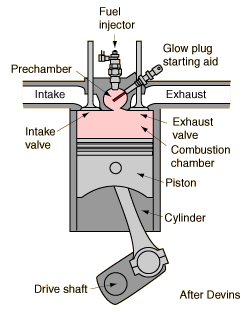Hello friends, in this occasion we are going to talk a little about the basics of internal combustion engines according to the type of combustion and the type of movement they make.

Source
Internal combustion engines have become essential in our daily lives. OTTO gasoline engines are used in lighter vehicles such as cars, motorcycles and small planes, due to their good power-to-weight ratio, while DIESEL engines are used in heavier vehicles such as trucks, railways and ships. for their Part, the WANKEL rotary engine despite its promising future has not found adequate industrial development due to the complexity of the sealing system of the combustion chamber.
The internal combustion engines are classified according to their type of combustion in: Explosion and continuous combustion, and in turn the explosion engines are classified according to their type of movement in Alternative and Rotary.
In this first part we are going to talk about the explosion engines, leaving for the second part the continuous combustion engines.
Alternative Explosion Engines:
Among them are spark ignition (OTTO) and compression ignition (DIESEL). The explosion engines contain an interesting repertoire of mechanisms and technical systems such as the crank, which performs the main function, which is the transformation of the energy of expansion of the combustion gases on a reciprocating piston in a Useful rotation work on the crankshaft.
Two-stroke Gasoline Engines:
In the two-stroke engine there is an explosion for each turn of the crankshaft, with which the power per unit of weight is greater than in the four-stroke engine, but as the combustion is less perfect, consumption increases.
One of the most important advantages of the two-stroke engine is the elimination of the valve distribution system, which significantly alijera and simplifies this type of mechanism.
Phases of a Two-stroke Engine:
Combustion-Exhaust: After the explosion, the work stroke takes place until the piston leaves the exhaust port open, which starts the exit of burned gases.
Admsion and compression: Upon reaching its position below, the piston leaves the transfer port open, and the compressed gases in the lower part of the engine pass to the top and finish sweeping the burned gases, immediately afterwards, in its stroke of rise, the piston closes the ports of admission and exhaust and coprime the gases until starting a new cycle.

Source
Another ploblema added in two-stroke engines is that the gasoline, when circulating in the lower part of the engine, could dissolve the oil and leave the main organs of the engine without lubrication.This problem is solved by mixing a small amount of oil in the gasoline that after lubricating the moving parts burns with the fuel.
Four-stroke Gasoline Engine:
It is said that an engine is four times when its cycle is performed in four strokes of the piston or two turns of the crankshaft with which you get a lower power, in relation to the weight, than the two-stroke, however, filling and the emptying are more complete in each cycle, which causes that the four-stroke engines have lower consumption.
Phases of a Four-stroke Engine:
Admission: With the intake valve open, the piston, moving towards the crankshaft, sucks the combustible air fluid.
Compression: With the two valves closed, the piston moves counter-clockwise and compresses the combustion mixture.
Explosion: Once the combustion mixture is compressed, the explosion is caused which gives rise to the expansion stroke which produces the useful work.
Exhaust: With the exhaust valve open, there is a final stroke of the piston, which drives the burned gases outwards, and the cycle starts again.

Source
Diesel engines:
Diesel engines are compression ignition, that is, they operate by a different principle than the gasoline engine. Admission and compression is done only with air, but unlike the Otto engine, the compression ratio is much higher, so the air reaches a higher temperature. The fuel is then injected directly into the cylinder and spontaneous combustion occurs due to the temperature, so that each diesel engine has a multiple fuel injection pump in each cylinder.

Source
References:
Gran Enciclopedia Interactiva Siglo XXI, Tomo VI, Editorial Océano.
Encicopedia de la Ciencia y de la Técnica, Tomo V, Ediciones DANAE S.A.
For more information you can visit:
https://www.britannica.com/technology/diesel-engine
https://xorl.wordpress.com/2011/03/05/the-basics-of-4-stroke-internal-combustion-engines/
I'm an engineering, and this is a very explanatory and interesting.